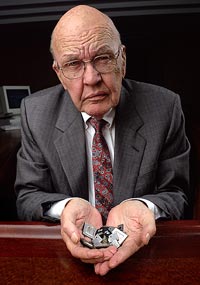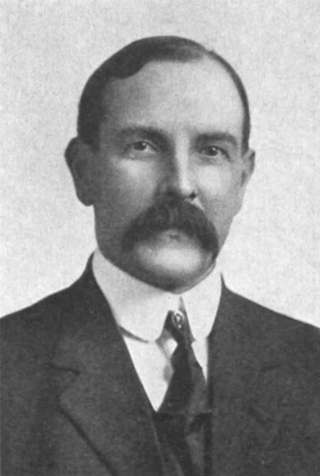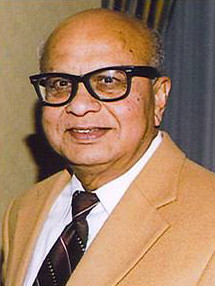
Charles Proteus Steinmetz was a German-American mathematician and electrical engineer and professor at Union College. He fostered the development of alternating current that made possible the expansion of the electric power industry in the United States, formulating mathematical theories for engineers. He made ground-breaking discoveries in the understanding of hysteresis that enabled engineers to design better electromagnetic apparatus equipment, especially electric motors for use in industry.

Jack St. Clair Kilby was an American electrical engineer who took part in the realization of the first integrated circuit while working at Texas Instruments (TI) in 1958. He was awarded the Nobel Prize in Physics on December 10, 2000. Kilby was also the co-inventor of the handheld calculator and the thermal printer, for which he had the patents. He also had patents for seven other inventions.

Arthur Edwin Kennelly was an American electrical engineer.
The Institute of Radio Engineers (IRE) was a professional organization which existed from 1912 until December 31, 1962. On January 1, 1963, it merged with the American Institute of Electrical Engineers (AIEE) to form the Institute of Electrical and Electronics Engineers (IEEE).
August Uno Lamm was a Swedish electrical engineer and inventor. He was sometimes called "The Father of High Voltage Direct Current" power transmission. During his career, Lamm obtained 150 patents. In 1980 the Institute of Electrical and Electronics Engineers (IEEE) developed the Uno Lamm High Voltage Direct Current Award for contributions to the field of high voltage electrical engineering.
Chung Laung Liu, also known as David Liu or C. L. Liu, was a Taiwanese computer scientist. Born in Guangzhou, he spent his childhood in Macau. He received his B.Sc. degree in Taiwan, master's degree and doctorate in United States.

Benjamin Garver Lamme was an American electrical engineer and chief engineer at Westinghouse, where he was responsible for the design of electrical power machines. Lamme created an efficient induction motor from Nikola Tesla's patents and went on to design the giant Niagara Falls generators and motors and the power plant of the Manhattan Elevated Railway in New York City.
The IEEE Edison Medal is presented by the Institute of Electrical and Electronics Engineers (IEEE) "for a career of meritorious achievement in electrical science, electrical engineering, or the electrical arts." It is the oldest medal in this field of engineering. The award consists of a gold medal, bronze replica, certificate, and honorarium. The medal may only be awarded to a new leap/breakthrough in the technological area of science.

The IEEE Medal of Honor is the highest recognition of the Institute of Electrical and Electronics Engineers (IEEE). It has been awarded since 1917, when its first recipient was Major Edwin H. Armstrong. It is given for an exceptional contribution or an extraordinary career in the IEEE fields of interest. The award consists of a gold medal, bronze replica, certificate, and honorarium. The Medal of Honor may only be awarded to an individual.
Charles Concordia was a noted American electrical engineer specializing in electrical power engineering and the early history of computer hardware.

Lewis Buckley Stillwell was an American electrical engineer and the president of American Institute of Electrical Engineers (AIEE) from 1909 to 1910. He received the AIEE Lamme Medal (1933) and the AIEE Edison Medal (1935), for "his distinguished engineering achievements and his pioneer work in the generation, distribution, and utilization of electric energy." He also was inducted into the IEEE's Electrical Engineering Hall of Fame. His papers (1886-1939) are held in the Manuscript Division of the Princeton University Library. He was elected as a member of the National Academy of Sciences in 1921.

Joseph Slepian (February 11, 1891 – December 19, 1969) was an American electrical engineer known for his contributions to the developments of electrical apparatus and theory.

Comfort Avery Adams was an American electrical engineer who as a student helped Albert A. Michelson with the Michelson–Morley experiment (1887), which was later viewed as confirming the special relativity theory of Albert Einstein (1905). He was a recipient of the IEEE Edison Medal and AIEE Lamme Medal.

Yu Hsiu Ku or Gu Yuxiu was a Chinese-American electrical engineer, musician, novelist, poet, and politician. A polymathic academic, he was one of the first Chinese people to earn a doctorate from the Massachusetts Institute of Technology, in 1928, and became a leader in higher education in China until the fall of the Republic of China in 1949. Afterwards, he worked for many years as a professor of electrical engineering at the University of Pennsylvania.
Bantval Jayant Baliga is an Indian electrical engineer best known for his work in power semiconductor devices, and particularly the invention of the insulated gate bipolar transistor (IGBT).
Ernst Weber, Austria-born American electrical engineer, was a pioneer in microwave technologies and played an important role in the history of the New York University Tandon School of Engineering, where in 1945 he founded the Microwave Research Institute. Weber was also the first president of the Institute of Electrical and Electronics Engineers (IEEE) and one of the founders of the U.S. National Academy of Engineering (NAE).

Bimal Kumar Bose, also known as B. K. Bose, is an electrical engineer, artificial intelligence researcher, scientist, educator, and currently a professor emeritus of power electronics in the Department of Electrical Engineering and Computer Science at the University of Tennessee, Knoxville.
Robert H. Park was an American electrical engineer and inventor, best known for the Park's transformation, used for simplifying the analysis of three-phase electric circuits. His related 1929 concept paper ranked second, when looking at the impact of all twentieth century power engineering papers. Park was an IEEE Fellow and a member of the National Academy of Engineering.
Subhasish Mitra is an American Computer Science and Electrical Engineering professor at Stanford University. He directs the Stanford Robust Systems Group, leads the Computation Focus Area of the Stanford SystemX Alliance, and is a member of the Wu Tsai Neurosciences Institute. His research ranges across Robust Computing, NanoSystems, Electronic Design Automation (EDA), and Neurosciences.









